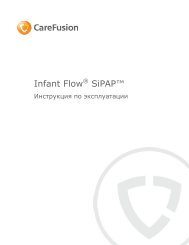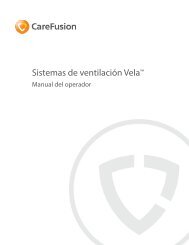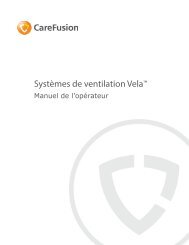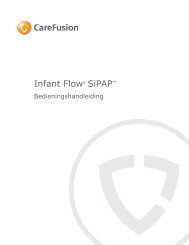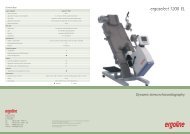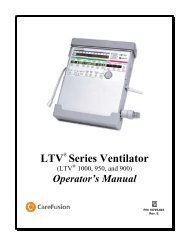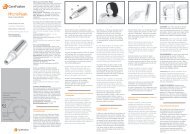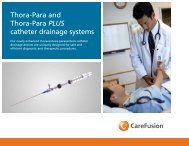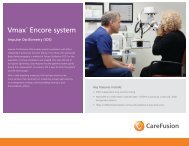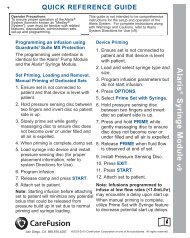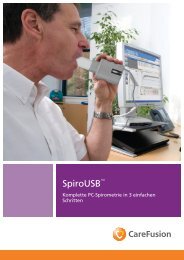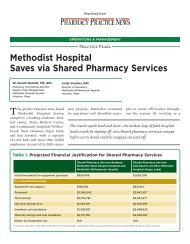Patient Controlled Analgesia (PCA) Guidelines of Care - CareFusion
Patient Controlled Analgesia (PCA) Guidelines of Care - CareFusion
Patient Controlled Analgesia (PCA) Guidelines of Care - CareFusion
You also want an ePaper? Increase the reach of your titles
YUMPU automatically turns print PDFs into web optimized ePapers that Google loves.
TOOL KIT<br />
<strong>Patient</strong> <strong>Controlled</strong> <strong>Analgesia</strong><br />
(<strong>PCA</strong>) <strong>Guidelines</strong> <strong>of</strong> <strong>Care</strong><br />
For the Opioid Naïve <strong>Patient</strong><br />
Revised: December 2009
About This Document<br />
The purpose <strong>of</strong> this document is to provide San Diego County Acute <strong>Care</strong> settings with recommendations for the<br />
standardization <strong>of</strong> intravenous <strong>Patient</strong> <strong>Controlled</strong> <strong>Analgesia</strong> (<strong>PCA</strong>) medication administration in the care <strong>of</strong> the<br />
opioid naïve patient. These recommendations exclude the use <strong>of</strong> epidural <strong>PCA</strong> (PCEA), subcutaneous <strong>PCA</strong> use, the<br />
palliative care environment, and patients experiencing chronic pain.<br />
Intended Audience<br />
The document is intended for the Acute <strong>Care</strong> Clinical Leader.<br />
Organization <strong>of</strong> This Document<br />
The document is organized into two main sections: recommended clinical guidelines for Opioid <strong>PCA</strong> usage, and<br />
recommended plan for implementing the guidelines in your institution.<br />
Acknowledgement<br />
The San Diego <strong>Patient</strong> Safety Council wishes to acknowledge the financial contribution and in-kind support<br />
provided by Cardinal Health, Inc./<strong>Care</strong>Fusion, as well as each <strong>of</strong> the institutions listed on the cover that<br />
contributed the valuable time <strong>of</strong> its expert clinicians in the creation <strong>of</strong> this document.<br />
San Diego <strong>Patient</strong> Safety Council: <strong>PCA</strong> Members<br />
Facilitator: Nancy Pratt, RN, MSN, Senior Vice President, Clinical Effectiveness, Sharp Health<strong>Care</strong><br />
Alvarado Hospital<br />
Peg Tilley, RN, BSN<br />
Diana Schultz, RPh, MHSA<br />
<strong>Care</strong>Fusion<br />
Steve Lewis, MD<br />
Tim Vanderveen, PharmD, MS<br />
Hospital Association <strong>of</strong> San Diego<br />
and Imperial Counties<br />
Sapna Dharkar-Surber, MPH<br />
Naval Medical Center San Diego<br />
Yuet-Hing Lam, RPh<br />
Palomar Pomerado Health<br />
John H. Eastham, PharmD<br />
Catherine Konyn, RN, CNS<br />
Bunny Krall, RN, MSN, CNS<br />
Rady Children’s Hospital San Diego<br />
Rebecca Bennett, RN, PNP<br />
Charles "Rich" Richards, PharmD<br />
Scripps Health<br />
Susan Dempsey, RN, MN, CNS<br />
Christine Low, PharmD<br />
Mark Parmenter, PharmD<br />
Sharp Health<strong>Care</strong><br />
Cheryl Dailey, RN, MS<br />
John Engelbert, PharmD<br />
Steve Leary, RN<br />
Paul Neves, RN<br />
Albert Rizos, PharmD<br />
UCSD<br />
Julie Abraham, PharmD<br />
Diana Jung, PharmD<br />
VA Healthcare San Diego<br />
Jennifer Howard, PharmD<br />
Kimberly Quicci-Roberts, MS<br />
Karen Carroll, RN, MS, CNS<br />
Contents<br />
Introduction ................................................................................................................................... 3<br />
Current State................................................................................................................................ 3<br />
Goal Charter ................................................................................................................................. 4<br />
Performance Improvement ............................................................................................................. 4<br />
The Pain Management Process ........................................................................................................ 4<br />
<strong>Guidelines</strong> for <strong>PCA</strong> Usage................................................................................................................ 5<br />
Starting Standard Orders................................................................................................................ 5<br />
Conversion Instruction/Table .......................................................................................................... 6<br />
Assessment for <strong>PCA</strong> Appropriateness ............................................................................................... 6<br />
Monitoring .................................................................................................................................... 9<br />
Adjuvant Therapies.......................................................................................................................11<br />
Complementary Therapies .............................................................................................................12<br />
<strong>Guidelines</strong> for Implementing <strong>PCA</strong> <strong>Care</strong> ......................................................................................... 12<br />
Mobilize Commitment....................................................................................................................12<br />
Define and Evaluate the Current State ............................................................................................12<br />
Create a Shared Need ...................................................................................................................12<br />
Standardize, Simplify, and Clarify ...................................................................................................13<br />
Appendices ................................................................................................................................... 15<br />
Appendix A. Vendor Specific <strong>PCA</strong> Ordering/Programming Terms .........................................................15<br />
Appendix B. Sample Standard IV <strong>PCA</strong> Order Set for Opioid Naïve ADULT <strong>Patient</strong>s.................................16<br />
Published December 2008; Revised December 2009. This document is in the public domain and may be used and reprinted without permission provided appropriate reference<br />
is made to the San Diego <strong>Patient</strong> Safety Council. The information and tools in this document are also available in electronic format at: www.alvaradohospital.com,<br />
http://www.carefusion.com/center/, www.hasdic.org, www.pph.org, www.scripps.org, riskmanagement.ucsd.edu, and www.sharp.com.<br />
Cardinal Health does not accept any responsibility for the information contained in this document.<br />
San Diego <strong>Patient</strong> Safety Council<br />
<strong>PCA</strong> <strong>Guidelines</strong> <strong>of</strong> <strong>Care</strong>
<strong>PCA</strong> <strong>Guidelines</strong> <strong>of</strong> <strong>Care</strong> Revised December 2009<br />
Introduction<br />
<strong>Patient</strong> <strong>Controlled</strong> <strong>Analgesia</strong> (<strong>PCA</strong>) is an<br />
interactive method <strong>of</strong> pain management that permits<br />
patients to manage their pain by self-administering<br />
doses <strong>of</strong> analgesics, usually opioids. 1<br />
Current State<br />
<strong>Patient</strong> <strong>Controlled</strong> <strong>Analgesia</strong> (<strong>PCA</strong>) can be an effective<br />
tool in reducing pain. However, IV medications in<br />
general are associated with the highest risk <strong>of</strong> harm to<br />
patients, and opioids are typically considered among<br />
the highest risk injectable medications. 2<br />
<strong>PCA</strong> is a complicated, yet highly flexible means <strong>of</strong><br />
providing opioids, consisting <strong>of</strong> several regimen<br />
elements addressed primarily in the Ordering and<br />
Administration stages <strong>of</strong> the medication process. 3<br />
For the purpose <strong>of</strong> this document, <strong>PCA</strong> prescription<br />
elements will respect the nomenclature outlined in<br />
Vendor Specific <strong>PCA</strong> Ordering/Programming Terms (see<br />
Appendix A). A cross-walk also is provided for<br />
available <strong>PCA</strong> devices.<br />
The use <strong>of</strong> <strong>PCA</strong> is a complex, high-risk treatment that<br />
is associated with harmful events and death. 4<br />
Extensive variability exists within and between<br />
hospital environments. Variability in patient response,<br />
clinical staffing, equipment, physician orders,<br />
medication dosages, and concentrations all contribute<br />
to risk for error.<br />
There is a shared need amongst hospitals to address<br />
<strong>PCA</strong> <strong>Guidelines</strong> <strong>of</strong> <strong>Care</strong> for the Opioid Naïve <strong>Patient</strong>.<br />
Every clinician and hospital environment has a <strong>PCA</strong><br />
story 5 , such as is evident in the national MedMARX<br />
database <strong>of</strong> voluntarily reported medication errors:<br />
• <strong>PCA</strong> errors represent a four-fold higher risk than<br />
other reported medication errors:<br />
<strong>PCA</strong> errors account for approximately one<br />
percent <strong>of</strong> all medication errors, but 6.5 percent<br />
were harmful.<br />
• <strong>PCA</strong> errors occur in every phase <strong>of</strong> the medicationuse<br />
process.<br />
1 Pasero C, McCaffery M. (2004). Safe use <strong>of</strong> continuous infusion with IV <strong>PCA</strong>. J<br />
PeriAnesth Nurs. 19(1), 42-45.<br />
2<br />
ISMP. List <strong>of</strong> high-alert medications. (2008). www.ismp.org/tools/highalertmedications.pdf.<br />
The Joint Commission. High-alert medications and patient safety. Sentinel Event Alert.<br />
Issue 11. Nov. 19, 1999.<br />
3<br />
The Joint Commission. Standards Initiative Medication Management: Medication<br />
Management Practices stages.<br />
www.jointcommission.org/NR/rdonlyres/B0D4CAB2-787C-4564-B408-<br />
D3EB138EDB6D/0/HAP_MM_Outline.pdf.<br />
4<br />
Hicks RW, Sikirica V, Nelson W, Schein JR, Cousins, DD. (Mar 2008). Medication<br />
errors involving patient-controlled analgesia. Am. J. Health Syst. Pharm. 65, 429-<br />
440.<br />
5<br />
Lotsch J, Dudziak R, Freynhagen R, Marschner J, Geisslinger, G. (2006). Fatal<br />
respiratory depression after multiple intravenous morphine injections. Clin<br />
Pharmacokinet. 45, 11. Adis Data Information BV.<br />
San Diego <strong>Patient</strong> Safety Council<br />
• <strong>PCA</strong> errors involve many disciplines including<br />
nurses, pharmacists, and physicians.<br />
• <strong>PCA</strong> process is highly error prone and represents<br />
opportunities for improvement including the need<br />
to simplify, standardize, and clarify, as follows:<br />
Equipment-related issues present challenges<br />
including pump misprogramming, complexity,<br />
and confusion <strong>of</strong> <strong>PCA</strong> screens and drug<br />
selection options.<br />
Administration is especially vulnerable, with less<br />
opportunity to intercept an error as there is no<br />
inherent redundancy in this stage. Landmark<br />
medication safety research has found only a 0-2<br />
percent medication error interception rate in the<br />
Administration stage. 6<br />
In 1999, the Joint Commission recommended these<br />
practice changes to improve opioid safety:<br />
• Limit the opiates and narcotics available in floor<br />
stock.<br />
• Educate staff about HYDROmorphone and<br />
morphine mix-ups.<br />
• Implement <strong>PCA</strong> protocols that include doublechecking<br />
<strong>of</strong> the drug, pump setting, and dosage.<br />
Other health care leaders also have strongly advocated<br />
for process simplification and standardization,<br />
including the Institute for Safe Medication Practice as<br />
published in their most recent safety improvement<br />
recommendations (summarized here): 7<br />
• Assess vulnerability to serious errors. Medication<br />
safety teams should review current practices around<br />
the use <strong>of</strong> custom concentrations.<br />
• Limit concentrations. When possible, a single,<br />
standard concentration for each <strong>PCA</strong> drug should<br />
be used. If more than one concentration is deemed<br />
necessary by the organization, the number <strong>of</strong><br />
standard concentrations should be limited to two<br />
at the most. Additionally, the use <strong>of</strong> custom<br />
concentrations should be minimized and, when<br />
possible, restricted to selected patient care areas.<br />
• Distinguish custom concentrations. When a<br />
custom concentration is necessary, the container<br />
label should be very distinctive and should not look<br />
like the standard <strong>PCA</strong> syringe/bag label. Auxiliary<br />
labels (e.g., “High-Potency”) and a different color<br />
pharmacy label with specific instructions for<br />
programming the pump should be used for custom<br />
concentrations.<br />
• Clarify the label. Institute for Safe Medication<br />
Practices (ISMP) usually recommends presenting<br />
the total drug concentration in the bag/syringe<br />
first, followed by the amount <strong>of</strong> drug per mL below<br />
this within the same background or border on the<br />
product label.<br />
6<br />
Leape L, Bates DW, Cullen DJ, et al. (1995) JAMA. 274(1), 35-43.<br />
Bates DW, Cullen DJ, Laird N, et al. (1995). JAMA. 274(1), 29-34.<br />
7<br />
ISMP. Misprogramming <strong>PCA</strong> concentration leads to dosing errors. August 28, 2008<br />
issue. www.ismp.org/d/SpecialFollowUp.pdf.<br />
3
<strong>PCA</strong> <strong>Guidelines</strong> <strong>of</strong> <strong>Care</strong> Revised December 2009<br />
Depending on the <strong>PCA</strong> pump vendor, the user may<br />
be prompted to enter the concentration in a<br />
mg/mL strength. In these cases, it would be safer<br />
to indicate the concentration with the amount <strong>of</strong><br />
drug per mL listed first, followed by the total<br />
amount <strong>of</strong> drug/total volume in the syringe/bag.<br />
• Match the MAR to the label. The concentration<br />
on the Medication Administration Record (MAR)<br />
should be listed the same as the <strong>PCA</strong> label.<br />
• Employ an independent double-check. The<br />
narcotics used for <strong>PCA</strong> are high-alert medications;<br />
thus, an independent double-check <strong>of</strong> the product<br />
and pump programming should be considered.<br />
When replacing an empty syringe/bag, the empty<br />
container should be compared to the new container<br />
to verify the concentration is the same.<br />
• Use barcoding technology. Some infusion pumps<br />
incorporate barcoding technology. Scanning the<br />
barcode on the <strong>PCA</strong> bag would help ensure the<br />
correct concentration is entered during <strong>PCA</strong><br />
programming.<br />
• Use smart pumps. <strong>PCA</strong> pumps with Dose Error<br />
Reduction System (DERS) should be used<br />
whenever possible. Because the significance <strong>of</strong> a<br />
low concentration alert during pump programming<br />
is not fully appreciated, low concentration limits<br />
should always be set as hard limits. Additionally,<br />
clinical advisories should be in place to reinforce<br />
caution when using custom concentrations.<br />
In 2000, the Institute <strong>of</strong> Medicine’s (IOM) original<br />
landmark patient safety report, “To Err Is Human:<br />
Building a Safer Health System” concluded:<br />
“<strong>Patient</strong> safety programs should…incorporate wellunderstood<br />
safety principles, such as standardizing and<br />
simplifying equipment, supplies, and processes.” 8<br />
The 2006 IOM report, “Preventing Medication Errors,”<br />
urges hospitals to take action to reduce the potential for<br />
errors. For all <strong>of</strong> these reasons and as part <strong>of</strong> continuing<br />
efforts to improve patient and medication safety, the San<br />
Diego <strong>Patient</strong> Safety Council was formed for community-<br />
wide patient safety improvements. San Diego County<br />
hospitals identified <strong>PCA</strong> as a significant opportunity to<br />
reduce morbidity and mortality.<br />
Goal Charter<br />
The San Diego <strong>Patient</strong> Safety Council members<br />
desired to develop county-wide, evidenced-based<br />
standards <strong>of</strong> care for safe and effective pain<br />
management using <strong>PCA</strong> in opioid naïve patients.<br />
Performance Improvement<br />
The San Diego <strong>Patient</strong> Safety Council consists <strong>of</strong><br />
representatives from county acute facilities and<br />
disciplines. Council members reviewed literature,<br />
applied process improvement tools, and obtained<br />
consensus to build a comprehensive set <strong>of</strong><br />
recommendations to prevent potential <strong>PCA</strong> errors<br />
throughout the county. The tool kit includes tools and<br />
information to assist acute care organizations in<br />
implementing these recommendations.<br />
Success will be achieved when a safe, effective<br />
standard <strong>of</strong> care for <strong>PCA</strong> usage is implemented across<br />
San Diego County, as evidenced by a reduction in<br />
potential and actual harmful events.<br />
The Pain Management Process<br />
In order to develop a standard <strong>of</strong> care, the council<br />
began by developing a high-level process map for pain<br />
management. This process is shown in Figure 1 and<br />
described as follows:<br />
1. The patient is assessed by a registered nurse and<br />
a physician. The physician should determine<br />
whether the patient is opioid naïve and therefore,<br />
a candidate for standard <strong>PCA</strong> orders. A registered<br />
nurse assesses the patient’s cognitive function to<br />
determine if the patient is able to understand and<br />
participate in pain management. The nurse also<br />
reviews with the patient any education materials,<br />
including what is pain assessment and how to<br />
achieve pain relief with the <strong>PCA</strong> pump.<br />
Figure 1: Pain Management Process<br />
8<br />
Kohn KT, Corrigan JM, Donaldson MS. (2000). To err is human: building a safer<br />
health system. IOM. Washington, D.C. National Academic Press. 156.<br />
4<br />
San Diego <strong>Patient</strong> Safety Council
<strong>PCA</strong> <strong>Guidelines</strong> <strong>of</strong> <strong>Care</strong> Revised December 2009<br />
2. The surgical procedure is performed by the<br />
physician and the physician implements the<br />
standard <strong>PCA</strong> orders. The pharmacist validates<br />
that the appropriate <strong>PCA</strong> orders are used, based<br />
on whether the patient is opioid naïve, and<br />
dispenses the standard <strong>PCA</strong> syringe. The orders<br />
are executed, as well as obtaining the appropriate<br />
supplies, drug, IV access, monitoring devices, and<br />
equipment.<br />
3. A registered nurse assesses the following: vital<br />
signs, pain, sedation, and rate and quality <strong>of</strong><br />
respirations. Additional patient education should<br />
be provided prior to starting the <strong>PCA</strong> pump. The<br />
<strong>PCA</strong> pump is set up by the registered nurse with<br />
the pump programming independently verified by<br />
another registered nurse. The pump settings are<br />
documented in the patient’s Medication<br />
Administration Record.<br />
4. A bolus <strong>of</strong> pain medication, if ordered, is<br />
administered by the registered nurse using the<br />
<strong>PCA</strong> pump. Subsequent doses <strong>of</strong> pain medication<br />
are self-administered by the patient using the <strong>PCA</strong><br />
pump. The medication administration and followup<br />
assessments are documented in the patient’s<br />
record.<br />
5. A registered nurse performs follow-up<br />
assessments and adjustments to the <strong>PCA</strong> settings<br />
based on standard orders. At consistent intervals,<br />
the nurse determines the patient’s response to the<br />
ordered pain management approach. Assessment<br />
results are documented in the patient’s chart.<br />
6. The result <strong>of</strong> the process is safe and effective pain<br />
control.<br />
Failure Modes<br />
As part <strong>of</strong> the current state assessment, the council<br />
conducted an analysis <strong>of</strong> potential failure modes with<br />
<strong>PCA</strong> usage. This information was valuable when the<br />
council worked through the medication administration<br />
process to problem-solve. The council attempted to<br />
address all <strong>of</strong> these failure modes in recommendations<br />
provided in this tool kit.<br />
<strong>Guidelines</strong> for <strong>PCA</strong> Usage<br />
Starting Standard Orders<br />
It is strongly recommended as a best practice for<br />
healthcare pr<strong>of</strong>essionals to use standard starting<br />
orders for <strong>PCA</strong> use to reduce the incidence <strong>of</strong><br />
respiratory depression and improve patient safety. 9<br />
Standard <strong>PCA</strong> Parameters for Opioid Naïve<br />
Adult <strong>Patient</strong>s<br />
The council identified the starting parameters for <strong>PCA</strong><br />
therapy for adults, as detailed in Table 1. This table<br />
provides parameters for the three most commonly<br />
used <strong>PCA</strong> drugs as a dosing conversion table. These<br />
orders are included in the complete standard order set<br />
in Appendix B.<br />
Table 1: Standard <strong>PCA</strong> Parameters for Opioid Naïve<br />
Adult <strong>Patient</strong>s<br />
Standard <strong>PCA</strong> Parameters for Opioid Naïve Adult <strong>Patient</strong>s<br />
1x (single strength)<br />
morphine HYDROmorphone fentaNYL<br />
1mg/ml<br />
0.2 mg/ml<br />
(200 mcg/ml)<br />
Loading Bolus 2 mg 0.4 mg<br />
(400 mcg)<br />
Clinician Bolus 2 mg 0.4 mg<br />
(400 mcg)<br />
Number <strong>of</strong> Clinician<br />
Boluses Per Hour<br />
<strong>PCA</strong> Dose<br />
10 mcg/ml<br />
20 mcg<br />
20 mcg<br />
1 1 1<br />
1 mg<br />
Lockout 10<br />
minutes<br />
Total Drug<br />
Over Time<br />
0.2 mg<br />
(200 mcg)<br />
10<br />
minutes<br />
10 mcg<br />
10<br />
minutes<br />
Optional Optional Optional<br />
Max Number <strong>of</strong><br />
<strong>Patient</strong> Demand<br />
Doses Per Hour<br />
Basal<br />
Optional Optional Optional<br />
Not recommended for starting <strong>PCA</strong><br />
9<br />
Weber LM, Ghafoor VL, Phelps P. (2008 Jun 15). Implementation <strong>of</strong> standard<br />
order sets for patient-controlled analgesia. Am J Health Syst Pharm. 65(12), 1184-<br />
1191.<br />
Pasero C. (February 2007). IV opioid range orders for acute pain management.<br />
AJN. 107(2), 52-59.<br />
Gammaitoni AR, Fine P, Alvarez N, McPherson ML, Bergmark S. (2003). Clinical<br />
application <strong>of</strong> opioid equianalgesic data. The Clinical Journal <strong>of</strong> Pain. 19, 286–297.<br />
San Diego <strong>Patient</strong> Safety Council<br />
5
<strong>PCA</strong> <strong>Guidelines</strong> <strong>of</strong> <strong>Care</strong> Revised December 2009<br />
Standard <strong>PCA</strong> Starting Orders for Opioid<br />
Naïve Pediatric <strong>Patient</strong>s<br />
The council identified the starting parameters for <strong>PCA</strong><br />
therapy for children, as detailed in Table 2. The same<br />
drugs used for adults are used for children, but in<br />
doses adjusted by body weight. Children should be<br />
assessed for developmental age and cognitive ability<br />
prior to initiating <strong>PCA</strong> use.<br />
Table 2: Standard <strong>PCA</strong> Parameters for Pediatric<br />
<strong>Patient</strong>s<br />
Standard <strong>PCA</strong> Parameters for PEDIATRIC <strong>Patient</strong>s<br />
Conversion Instruction/Table<br />
Physicians and other healthcare pr<strong>of</strong>essionals may be<br />
faced with switching to an alternative opioid during<br />
the course <strong>of</strong> a patient’s pain management. While <strong>PCA</strong><br />
may be administered subcutaneously, it is most<br />
common for advanced disease or end-<strong>of</strong>-life care.<br />
Subcutaneous <strong>PCA</strong> and Epidural <strong>PCA</strong> are beyond the<br />
scope <strong>of</strong> this project.<br />
The following conversion table is provided to assist<br />
health care pr<strong>of</strong>essionals in determining dosing when<br />
changing from IV to PO.<br />
Table 3: Equianalgesic Table Conversion IV to PO 10<br />
Equianalgesic Table Conversion IV to PO<br />
morphine HYDROmorphone fentaNYL<br />
Opioid Parenteral PO<br />
codeine 130 mg 200 mg<br />
1x (single strength) 1 mg/ml 200 mcg/ml 10 mcg/ml<br />
Loading Bolus 0.04<br />
mg/kg<br />
(40 mcg/kg)<br />
8<br />
mcg/kg<br />
0.5<br />
mcg/kg<br />
fentaNYL<br />
0.1 mg<br />
(100 mcg)<br />
HYDROcodone — 30 mg<br />
HYDROmorphone 1.5 mg 7.5 mg<br />
morphine 10 mg 30 mg<br />
—<br />
Clinician Bolus 0.04<br />
mg/kg<br />
(40 mcg/kg)<br />
8<br />
mcg/kg<br />
0.5<br />
mcg/kg<br />
oxymorphone 1 mg —<br />
oxyCODONE — 20–30 mg<br />
Number <strong>of</strong> Clinician<br />
Boluses Per Hour<br />
<strong>PCA</strong> Dose 0.01<br />
mg/kg<br />
(10 mcg/kg)<br />
2 2 2<br />
2<br />
mcg/kg<br />
0.25<br />
mcg/kg<br />
Lockout 10 minutes 10 minutes 10 minutes<br />
Basal / Continuous<br />
Rate <strong>of</strong> Infusion<br />
0.005<br />
mg/kg/hr<br />
Optional<br />
(5 mcg/kg/hr)<br />
1<br />
mcg/kg/hr<br />
Optional<br />
0.25<br />
mcg/kg/hr<br />
Optional<br />
Assessment for <strong>PCA</strong> Appropriateness<br />
Recommendations by the council for assessments<br />
prior to and throughout the administration <strong>of</strong> opioids<br />
using <strong>PCA</strong> are as follows:<br />
• Pre-Procedure Cognitive Assessment<br />
• Opioid Tolerant or Opioid Naïve?<br />
• Pain Assessment<br />
• Sedation Assessment<br />
• Respiratory Assessment.<br />
Further description <strong>of</strong> each assessment is described in<br />
the following sections.<br />
Total Drug Over Time 0.1<br />
mg/kg/hr<br />
(100<br />
mcg/kg/hr)<br />
Max Number <strong>of</strong><br />
<strong>Patient</strong> Demand<br />
Doses Per Hour<br />
Call if >3 in<br />
2 hours<br />
20<br />
mcg/kg/hr<br />
Call if >3 in<br />
2 hours<br />
3<br />
mcg/kg/hr<br />
Optional<br />
Call if >3 in<br />
2 hours<br />
Pre-Procedure Cognitive Assessment<br />
<strong>PCA</strong> requires patients to be active participants in their<br />
pain relief. The purpose <strong>of</strong> the cognitive assessment is<br />
to determine if a patient is capable <strong>of</strong> participating in<br />
his/her pain management.<br />
For this reason, it is necessary to evaluate the<br />
patient’s mental status, level <strong>of</strong> consciousness, and<br />
developmental status to be sure that <strong>PCA</strong> is an<br />
appropriate method to manage pain. This can be<br />
accomplished with a standard nursing assessment. 11<br />
10<br />
Patanwala AE, Duby J, Waters D, and Erstad BL. (2007). Opioid conversions in<br />
acute care. The Annals <strong>of</strong> Pharmacotherapy. 41, 255-267.<br />
11<br />
The Joint Commission. (December 20, 2004). <strong>Patient</strong> controlled analgesia by<br />
proxy. Sentinel Event Alert. Issue 33.<br />
6<br />
San Diego <strong>Patient</strong> Safety Council
<strong>PCA</strong> <strong>Guidelines</strong> <strong>of</strong> <strong>Care</strong> Revised December 2009<br />
Furthermore, it is recommended that <strong>PCA</strong> is initiated<br />
only when a patient is able to and has indicated the<br />
following:<br />
• A willingness to use <strong>PCA</strong> for pain management<br />
• An understanding <strong>of</strong> the relationship between pain,<br />
pressing the <strong>PCA</strong> button, and pain relief<br />
• An understanding <strong>of</strong> the dosing interval<br />
• A return demonstration <strong>of</strong> self-administering a <strong>PCA</strong><br />
dose by pushing the <strong>PCA</strong> button, or simulating this<br />
action if a <strong>PCA</strong> pump is not available<br />
<strong>PCA</strong> <strong>Patient</strong> Education<br />
<strong>Patient</strong> and family education is critical for safe,<br />
effective use <strong>of</strong><br />
<strong>PCA</strong>. Education<br />
must be<br />
provided to<br />
patients prior to<br />
initiation <strong>of</strong> <strong>PCA</strong><br />
Best Practice Recommendation:<br />
<strong>Patient</strong> education should be done preoperatively<br />
for post-operative use <strong>of</strong> <strong>PCA</strong>.<br />
and must address their role in managing their pain,<br />
specific information on pump operation, safety<br />
measures, and when to alert a nurse. Education must<br />
include family members to clearly emphasize the<br />
hazards <strong>of</strong> anyone other than the patient<br />
administering a <strong>PCA</strong> dose. Serious adverse events can<br />
result when family members administer “<strong>PCA</strong> by<br />
proxy.”<br />
Written and verbal patient education must include the<br />
following elements:<br />
• Definition <strong>of</strong> what <strong>PCA</strong> is and the patient’s<br />
responsibility in managing pain.<br />
• Clarification <strong>of</strong> the goal <strong>of</strong> pain management: not to<br />
completely eliminate pain, but to effectively control<br />
pain so the patient can engage in therapeutic<br />
activities.<br />
• General pump operation and function <strong>of</strong> the <strong>PCA</strong><br />
button.<br />
• Safety features <strong>of</strong> the pump to prevent overdose,<br />
such as pump delay or lockout interval, limit on<br />
total dosage in a set time interval, and patient<br />
administered dosing.<br />
• Prominent warning on dangers <strong>of</strong> <strong>PCA</strong> by proxy.<br />
• Elements, purpose, and frequency <strong>of</strong> ongoing<br />
monitoring, so the patient understands and<br />
expects to be awakened/to be monitored frequently<br />
to assess level <strong>of</strong> sedation.<br />
• Description <strong>of</strong> when to alert the nurse: inadequate<br />
pain control; side effects such as nausea,<br />
sleepiness, itching, and constipation; help with<br />
getting out <strong>of</strong> bed; and any safety concerns,<br />
such as pump operation.<br />
Verbal instruction is essential to verify patient<br />
understanding, preferably pre-operatively for the<br />
patient undergoing surgery. A written resource or<br />
handout also is necessary to reinforce <strong>PCA</strong><br />
information. Offering written resources in a<br />
language the patient understands should be<br />
considered.<br />
Opioid Tolerant or Opioid Naïve?<br />
Critical to the pain management process is<br />
determining if the patient is opioid naïve or opioid<br />
tolerant. The following definitions should be used as<br />
guidelines when determining a patient’s opioid status:<br />
Definition <strong>of</strong> Opioid Tolerant<br />
“<strong>Patient</strong>s who are considered opioid-tolerant are<br />
those who have been taking, for a week or longer, at<br />
least 60 mg <strong>of</strong> morphine daily, or at least 30 mg <strong>of</strong><br />
oral oxycodone daily, or at least 8 mg <strong>of</strong> oral<br />
HYDROmorphone daily, or an equianalgesic dose <strong>of</strong><br />
another opioid.” (Food and Drug Administration)<br />
This history must immediately precede the<br />
intended course <strong>of</strong> <strong>PCA</strong> therapy. If a wash-out<br />
period <strong>of</strong> a week or longer has occurred since the<br />
above dosages were taken, reconsider whether the<br />
patient truly meets this definition <strong>of</strong> tolerance.<br />
Definition <strong>of</strong> Opioid Naïve<br />
<strong>Patient</strong>s who do not meet the definition <strong>of</strong> opioid<br />
tolerant, who have not had narcotics doses at least<br />
as much as those listed above for a week or more,<br />
are considered to be opioid naïve.<br />
If the patient is opioid tolerant and in need <strong>of</strong> chronic<br />
pain management, it is recommended that experts for<br />
pain management are consulted. If the patient is opioid<br />
naïve and needs postoperative pain management, the<br />
orders contained within this tool kit are suggested.<br />
Pain Assessment<br />
Consistent pain assessment is essential to support<br />
appropriate continued monitoring and evaluation <strong>of</strong> a<br />
treatment’s effectiveness. Standard pain assessment is<br />
useful for eliciting a patient’s response or description<br />
<strong>of</strong> discomfort, as well as ensuring clear<br />
communication. It is useful to show the patient each<br />
<strong>of</strong> these scales to see which they feel best helps them<br />
describe the pain.<br />
Council members’ recommended tool for pain<br />
assessment is the 0-10 Pain Faces Scale (Wong-Baker<br />
Faces Scale), Figure 3. This scale combines facial<br />
expressions, textual description, and numeric values<br />
ascribed to pain level. This scale was originally<br />
developed in the pediatric environment, and then<br />
extended to adults as the cartoon faces proved to<br />
avoid gender, age, and racial bias. This scale is<br />
recommended for patients three years to adult.<br />
Figure 3: Wong-Baker Faces Scale<br />
San Diego <strong>Patient</strong> Safety Council<br />
7
<strong>PCA</strong> <strong>Guidelines</strong> <strong>of</strong> <strong>Care</strong> Revised December 2009<br />
Sedation Assessment<br />
Sedation precedes respiratory depression as less<br />
opioid is required to produce it. Therefore, the most<br />
effective monitoring <strong>of</strong> the patient receiving opioids is<br />
the systematic ongoing assessment for sedation. For<br />
patient’s using <strong>PCA</strong>, sedation assessment is critical.<br />
The council conducted a thorough literature review <strong>of</strong><br />
Pasero, Ramsey, and RASS sedation scales. 11 12<br />
Council members also discussed thoroughly which<br />
sedation scale to select. RASS is the top choice<br />
because it is concise, simple to use, and combines<br />
sedation and agitation into one scale.<br />
Some members <strong>of</strong> the council have elected to use the<br />
Pasero scale in their organization specifically for<br />
opioid-induced sedation. While there was not a<br />
consensus on a specific scale, the council recommends<br />
using a consistent scale across the organization for<br />
sedation assessment. It also is recommended that<br />
sedation assessment scales use patient behavioral<br />
descriptors as scale reference points. RASS and<br />
Pasero scales have been included in this tool kit for<br />
reference (Tables 4 and 5).<br />
Best Practice Recommendation:<br />
It is recommended that a healthcare organization use one<br />
sedation assessment scale for <strong>PCA</strong> opioid use.<br />
Table 4: Richmond Agitation Sedation Scale (RASS) 12<br />
Richmond Agitation Sedation Scale (RASS)<br />
Score - Term – Description<br />
+4 Combative<br />
Overtly combative, violent, immediate danger to staff<br />
+3 Very Agitated<br />
Pulls or removes tube(s) or catheter(s), aggressive<br />
+2 Agitated<br />
Frequent non-purposeful movement, fights ventilator<br />
+1 Restless<br />
Anxious but movements not aggressive, vigorous<br />
0 Alert and Calm<br />
-1 Drowsy<br />
Not fully alert, but has sustained awakening (>10 seconds)<br />
(eye-opening/eye contact) to voice<br />
-2 Light Sedation<br />
Briefly awakens with eye contact to voice (
<strong>PCA</strong> <strong>Guidelines</strong> <strong>of</strong> <strong>Care</strong> Revised December 2009<br />
Respiratory Assessment<br />
Monitoring <strong>of</strong> a patient’s respiratory status with<br />
ongoing sedation assessment is critical to detecting<br />
respiratory depression in opioid-sedated patients on<br />
<strong>PCA</strong>. 14 15<br />
The council recommends respiratory rate and quality<br />
<strong>of</strong> respirations should be included in a respiratory<br />
assessment, as follows:<br />
Respiratory Rate: Should be counted for 30 seconds<br />
and if respiratory rate is less than 12/minute, then it<br />
should be counted for a full minute. Respiratory rates<br />
vary a great deal, and normal has quite a wide range.<br />
Regarding <strong>PCA</strong> use, a respiratory rate below 8/minute<br />
should concern anyone. A rate below 9/minute is<br />
probably where most clinicians would draw the line,<br />
but many policies use 10/minute as a cut-<strong>of</strong>f where<br />
opioids would be discontinued. The rate <strong>of</strong> respiration<br />
assessment should be made in context with sedation<br />
and pain assessments.<br />
Quality <strong>of</strong> Respirations: The quality <strong>of</strong> respirations is<br />
usually determined by the depth and pattern <strong>of</strong><br />
respirations, the level <strong>of</strong> effort, and adventitious<br />
sounds. The following terms can be used to describe<br />
the quality <strong>of</strong> respirations (normal in italics):<br />
• Depth:<br />
Normal: Chest or abdomen moves average depth<br />
with each breath not using accessory<br />
muscles<br />
Shallow: Slight movement <strong>of</strong> chest or abdomen<br />
Deep: Increased movement <strong>of</strong> chest or abdomen<br />
• Ventilatory Effort:<br />
Effortless/Comfortable: Appears relaxed, very little<br />
work to breathe<br />
Labored: <strong>Patient</strong> has to work hard to move air in<br />
and out; use <strong>of</strong> accessory muscles; nasal<br />
flaring; retractions (especially in infants<br />
and children)<br />
• Sound:<br />
Clear: Breathy sound when breathing in or out<br />
Blocked: Obstructed, stuffed sound when<br />
attempting to breathe in or out<br />
Noisy: Partially blocked sounds when breathing in<br />
or out<br />
Snoring: Partially blocked sounds when<br />
breathing in or out<br />
Gurgling: Fluids in the airway sounds when<br />
breathing in or out<br />
Stridor: Noisy harsh sound when breathing in or<br />
out<br />
14<br />
Seidel HM, Ball JW, Dains JE, Benedict GW. (2006). Mosby's guide to physical<br />
examination (ed. 6). St. Louis, MO: Elsevier.<br />
15<br />
Urden, L. D., Stacy, K. M., & Lough, M. E. (2006). Thelan’s critical care nursing<br />
(ed. 5). St. Louis, MO: Elsevier.<br />
San Diego <strong>Patient</strong> Safety Council<br />
Monitoring<br />
Complete Respiratory Assessment<br />
As opioids depress respiratory effort through central<br />
nervous system depression, evaluation <strong>of</strong> ventilatory<br />
status is essential. Using a method that would provide<br />
earlier warnings for respiratory problems could<br />
improve patient outcomes especially in those patients<br />
with known and/or unrecognized respiratory disease.<br />
The council examined the limits and benefits <strong>of</strong><br />
available monitoring devices. 16<br />
Best Practice Recommendation:<br />
Respiratory assessment should be performed by a<br />
registered nurse, and not be a delegated task.<br />
Pulse Oximetry (SpO2) Monitoring<br />
Recommendations<br />
Oxygen saturation is a prudent supplemental<br />
assessment measure in patients on <strong>PCA</strong> therapy,<br />
especially those with the following:<br />
• History <strong>of</strong> sleep apnea<br />
• Obesity<br />
• Conditions that decrease ventilatory capacity<br />
• Over 65 years<br />
Pulse oximetry is primarily useful for assessing<br />
changes in oxygenation; it is a late indicator <strong>of</strong><br />
ventilatory depression. 17 SpO2 readings may remain<br />
normal or near normal for minutes after a patient<br />
stops breathing. While it is not an early indicator <strong>of</strong><br />
ventilatory failure, it eventually falls as the patient<br />
stops breathing. Its ubiquitous presence in hospitals,<br />
simple measurement, and relatively low expense make<br />
it the monitor <strong>of</strong> choice.<br />
It is recommended that at a minimum the health care<br />
pr<strong>of</strong>essional monitor with pulse oximetry, yet be<br />
mindful <strong>of</strong> the limits to this useful device.<br />
Supplemental Oxygen Therapy<br />
Supplemental Oxygen Therapy obscures the effectiveness <strong>of</strong> using SpO2<br />
for a respiratory assessment. SpO2 assessment should be done on room<br />
air. For patients on <strong>PCA</strong> with supplemental oxygen therapy, there is no<br />
evidence that routine monitoring <strong>of</strong> oxygen saturation provides an<br />
additional measure <strong>of</strong> safety. It may provide a false sense <strong>of</strong> security, since<br />
decreased oxygen saturation is a very late sign <strong>of</strong> respiratory depression in<br />
these patients.<br />
16<br />
Overdyk FJ, Carter R, Maddox RR, Callura J, Herrin AE, Henriquez C. (2007).<br />
Continuous oximetry/capnometry monitoring reveals frequent desaturation and<br />
bradypnea during patient-controlled analgesia. Respiratory depression during<br />
<strong>PCA</strong>. Anesthesia & <strong>Analgesia</strong>. 105(2), 412-418.<br />
17<br />
Hutchison R, Rodriguez L. (2008). Pain control capnography and respiratory<br />
depression. AJN. 108(2), 35-39.<br />
9
<strong>PCA</strong> <strong>Guidelines</strong> <strong>of</strong> <strong>Care</strong> Revised December 2009<br />
Capnography (ETCO2) Monitoring<br />
Recommendations<br />
ETCO2 should be considered for assessing<br />
ventilation. Capnography measures ventilation<br />
continuously and is a more sensitive indicator <strong>of</strong><br />
hypercapnia. Early studies indicate that capnography<br />
is more effective than pulse oximetry in providing<br />
early warning <strong>of</strong> respiratory depression in patients<br />
receiving supplemental oxygen. While more research<br />
is required, early research shows that patients with<br />
the highest risk need additional monitoring –<br />
specifically ETCO2 monitoring for opioid-induced<br />
sedation. 18<br />
Capnography is capable <strong>of</strong> significantly clarifying the<br />
respiratory picture with regard to over-sedation, and<br />
when used in conjunction with oxygen saturation can<br />
dramatically enhance the overall picture <strong>of</strong> the<br />
patient’s respiratory status. Adding capnography to<br />
monitoring efforts can optimize patient safety.<br />
Although it is expensive and requires training, it is<br />
especially useful in patients on supplemental oxygen.<br />
Frequency and Elements <strong>of</strong> Monitoring<br />
Appropriate assessment drives clinical decisionmaking.<br />
The essential elements <strong>of</strong> a good assessment<br />
are evaluating the right indicators at the right<br />
intervals. Table 6 presents the council’s<br />
recommendations for <strong>PCA</strong> monitoring by registered<br />
nurses.<br />
Minimal recommended times for a nurse to evaluate<br />
pain, sedation, and respiratory assessment also are<br />
provided in Table 6. These critical times for<br />
evaluation are summarized as follows:<br />
• Baseline – prior to initiating the opioid<br />
• Initiation <strong>of</strong> the opioid – especially just after<br />
surgery as the patient likely still has opioids<br />
circulating from anesthesia<br />
• Any Change in Drug Supply:<br />
Change <strong>of</strong> syringe<br />
Change <strong>of</strong> settings<br />
Dose change or bolus<br />
• Event or Deterioration – such as over-sedation<br />
(i.e., RASS scale <strong>of</strong> -2)<br />
• At any time there is a “Hand-<strong>of</strong>f” <strong>of</strong> care:<br />
Transfer <strong>of</strong> care – recommend whenever there is<br />
a change in the patient’s care provider.<br />
At shift change – recommend that the person<br />
assuming care <strong>of</strong> the patient does an<br />
independent check <strong>of</strong> the pump settings, and<br />
the <strong>of</strong>f-going care provider and the on-coming<br />
care provider conduct the assessment together.<br />
• Document total amount <strong>of</strong> opioid used at the end<br />
<strong>of</strong> each shift. For those patients who have<br />
uncontrolled pain, knowing the amount <strong>of</strong><br />
opioids used each shift will help facilitate an<br />
easier transition to other routes <strong>of</strong><br />
administration.<br />
Table 6: Nursing Assessment Event & Frequency<br />
<strong>Guidelines</strong> for <strong>PCA</strong> Monitoring<br />
18<br />
McCarter, T; Shaik Z, Scarfo K, Thompson LJ. (2008). Capnography monitoring<br />
enhances safety <strong>of</strong> postoperative patient-controlled analgesia. American Health &<br />
Drug Benefits. 28-35. Available from http://www.AHDBonline.com.<br />
10<br />
San Diego <strong>Patient</strong> Safety Council
<strong>PCA</strong> <strong>Guidelines</strong> <strong>of</strong> <strong>Care</strong> Revised December 2009<br />
Adjuvant Therapies<br />
Nausea, vomiting, constipation, and itching are<br />
common opioid-induced side effects experienced by<br />
patients. Evidenced-based recommendations for<br />
treatments to relieve or treat these side effects are<br />
discussed in this section. The council strongly<br />
recommends that any order set for opioid-naïve <strong>PCA</strong><br />
use includes treatment for these conditions.<br />
Constipation Prevention and Treatment<br />
Individuals are considered constipated if bowel<br />
movement frequency is less than three times per<br />
week. 19 Determining the baseline bowel habits for a<br />
patient is recommended as part <strong>of</strong> the nursing<br />
assessment.<br />
The use <strong>of</strong> opioids for sedation puts each patient at<br />
risk for constipation. To address this side effect, the<br />
council conducted a review <strong>of</strong> literature to recommend<br />
a treatment. 20 In addition to this treatment, it is<br />
important to adjust the patient’s diet, activity, and<br />
fluid intake, as appropriate, to promote normal bowel<br />
habits. Recommendations for therapy dosage for<br />
opioid-induced constipation in adults and children are<br />
provided in Table 7.<br />
Table 7: Recommended Therapy for Opioid-Induced<br />
Constipation<br />
Recommended Therapy for Opioid-Induced Constipation<br />
Therapy Adult Pediatric<br />
1.) Start treatment with following therapy:<br />
Senna-S<br />
or<br />
Senna Plus<br />
Docusate<br />
2 tablets PO every<br />
morning<br />
Docusate 50 mg/ Sennoside<br />
8.6 mg/tablet PO BID<br />
2-5 yrs – ½ tablet<br />
6-12 yrs – 1 tablet<br />
Over 12 yrs – 2 tablets<br />
2.) If the above therapy is ineffective, try the following therapies:<br />
MOM 30 ml PO q6hrs PRN -<br />
Miralax - 17 gm/packet<br />
½-1 packet per age/weight<br />
Bisacodyl<br />
suppository<br />
1 suppository PR<br />
q6hrs PRN<br />
Less than 2 yrs – 5 mg/day<br />
single dose PRN<br />
2-11 yrs – 5-10 mg/day<br />
single dose PRN<br />
3.) If none <strong>of</strong> the above therapies are effective, try the following:<br />
Fleets Enema, PRN Pediatric Fleets, PRN<br />
Nausea/Vomiting<br />
Recommendations for therapy dosage for opioidinduced<br />
nausea and vomiting in adults and children<br />
are provided in Table 8 and Table 9. 21<br />
Table 8: Recommended Therapy Dosage for Opioid-<br />
Induced Nausea/Vomiting (Adults)<br />
Therapy<br />
Metoclopramide<br />
(Reglan)<br />
Promethazine<br />
(Phenergan)<br />
Ondansetron (Z<strong>of</strong>ran)<br />
Recommended Therapy Dosage for<br />
Opioid-Induced Nausea/Vomiting<br />
Adult<br />
10 mg IV q6hrs PRN nausea/vomiting<br />
(this agent is possibly advantageous over<br />
others if poor GI motility is considered the<br />
cause <strong>of</strong> Nausea/Vomiting)<br />
6.25 mg IV q6hrs PRN for nausea/vomiting<br />
Safety precautions: Dilute in 10 ml NS –<br />
assure IV patency before giving; give slowly; if<br />
patient complains <strong>of</strong> pain, stop!; use a large<br />
vein or preferably a central line if available;<br />
may repeat x1 if ineffective in 15 minutes<br />
4 mg IV q12hrs PRN nausea/vomiting if no<br />
relief in 30-60 minutes following<br />
administration <strong>of</strong> metoclopramide<br />
Table 9: Recommended Therapy Dosage for Opioid-<br />
Induced Nausea/Vomiting (Pediatrics)<br />
Therapy<br />
Metoclopramide (Reglan)<br />
Promethazine<br />
(Phenergan)<br />
Ondansetron (Z<strong>of</strong>ran)<br />
Recommended Therapy Dosage<br />
for Opioid-Induced Nausea/<br />
Vomiting<br />
Pediatrics<br />
0.15-0.25 mg/kg/dose IV q6hrs PRN<br />
(max 10 mg/dose)<br />
May be alternated with (Ondansetron<br />
(Z<strong>of</strong>ran) for severe nausea and vomiting)<br />
NO<br />
(Not to be used for children in general;<br />
FDA prohibits use in < 2 year olds)<br />
0.15 mg/kg/dose dose IV q6hrs PRN<br />
(max <strong>of</strong> 4 mg/dose)<br />
If the above is ineffective, then<br />
Metoclopramide (Reglan)<br />
19<br />
University <strong>of</strong> Iowa Gerontological Nursing Interventions Research Center,<br />
Research Translation and Dissemination Core. Management <strong>of</strong> Constipation<br />
Evidenced-Based Guideline. Written 1996, Revised 6/98, Reviewed 03/01.<br />
20<br />
Bisanz A, Woolery M, Lyons HF, Gaido L, Yenulevich MC, Fulton S. What<br />
interventions are effective for preventing and treating constipation in patient with<br />
cancer? ONS putting evidence into practice: constipation detailed PEP card.<br />
Literature search completed through September 2006. Oncology Nursing Society.<br />
Retrieved from http://www.ons.org.<br />
San Diego <strong>Patient</strong> Safety Council<br />
21<br />
Gan TJ, Meyer T, Apfel CC, Chung F, Davis PJ, Eubanks S, Kovac A, Philip BK,<br />
Sessler DI, Temo J, Trame`r MR, Watcha M. (2003). Consensus guidelines for<br />
managing postoperative nausea and vomiting. Anesth & Analg. 97, 62-71.<br />
11
<strong>PCA</strong> <strong>Guidelines</strong> <strong>of</strong> <strong>Care</strong> Revised December 2009<br />
Itching<br />
Itching is a common opioid-induced side effect<br />
experienced by patients, and it can be severe. For this<br />
reason, the council strongly recommends careful<br />
attention to itching and modifying treatment, as<br />
needed.<br />
Recommendations for therapy for opioid-induced<br />
itching in adults and children are:<br />
1.) Start treatment with the following therapy:<br />
Benadryl (diphenhydramine)<br />
2.) If the above therapy is ineffective, try the following agents:<br />
Atarax (hydrOXYzine)<br />
Nubain (nalbuphine)<br />
Zantac (ranitidine)<br />
Claritin (loratadine)<br />
Z<strong>of</strong>ran (ondansetron)<br />
3.) If none <strong>of</strong> the above therapies are effective, try the following:<br />
Switch opioid usage for <strong>PCA</strong> to fentaNYL<br />
Complementary Therapies<br />
There are other treatments that may be used to help<br />
manage pain in addition to opioid therapy.<br />
Complementary therapies and multimodal pain<br />
management provide an approach to managing pain<br />
at different pain pathways. These therapies should<br />
target reducing pain by 25 percent, which may reduce<br />
the amount <strong>of</strong> opioid needed. The net result may be<br />
fewer side effects <strong>of</strong> opioid therapy.<br />
Consider around-the-clock use <strong>of</strong> agents, such as:<br />
1. Acetaminophen<br />
2. Neurontin (gabapetin)<br />
3. Non-steroidal anti-inflammatory drugs:<br />
Ketorolac (toradol)<br />
Celebrex (celecoxib)<br />
<strong>Guidelines</strong> for Implementing<br />
<strong>PCA</strong> <strong>Care</strong><br />
This section provides a description <strong>of</strong> the methodology<br />
used by the council to develop the guidelines in this<br />
tool kit. It is recommended that this same<br />
methodology is used to implement <strong>PCA</strong> guidelines at a<br />
healthcare facility.<br />
Mobilize Commitment<br />
To start, form a council and manage resistance by<br />
identifying the organization stakeholders:<br />
• Critical <strong>Care</strong> Nurses • Intensivists<br />
• Acute <strong>Care</strong> Nurses • Ob-Gyn Nurses<br />
• Clinical Pharmacists • Ob-Gyn Physicians<br />
• Pharmacy Leadership • Anesthesia<br />
• Pharmacy<br />
Buyers/Wholesaler<br />
Supplier<br />
• Process Improvement<br />
Department<br />
• IS/IT Pharm-IT<br />
Department<br />
• CNO/Nursing<br />
Leadership<br />
• Pain Service<br />
• Pharmacy and<br />
Therapeutics<br />
Committee<br />
• Policy and Procedure<br />
Committee<br />
• Those responsible for<br />
standard order sets<br />
• CNS/Educators<br />
• Others, as needed<br />
Define and Evaluate the Current State<br />
The current state must be identified to effectively<br />
target change. The council needs to gather the data in<br />
preparation for implementing these recommendations.<br />
It is important to work with all stakeholders to obtain<br />
agreement on suggested standards for the<br />
organization. Recommended information would<br />
include:<br />
• Summarize <strong>PCA</strong> incidents or other quality<br />
indicators in the organization(s).<br />
• Identify the <strong>PCA</strong> equipment used.<br />
• Perform an area wide inventory <strong>of</strong> opioid<br />
medication concentrations and dosage units.<br />
• Perform an area wide inventory <strong>of</strong> assessment<br />
tools, practices, policies, and procedures.<br />
• Determine where variations exist in current practice.<br />
Create a Shared Need<br />
The case for standardization must be based on<br />
research, literature reviews, etc. Additionally,<br />
facilitation should be encouraged to allow for<br />
discussion and clarification on the front-end to be<br />
sure that the group is in full alignment on what is<br />
included and excluded in the project. The outcome<br />
should be a concise description <strong>of</strong> the case for<br />
standardization.<br />
12<br />
San Diego <strong>Patient</strong> Safety Council
<strong>PCA</strong> <strong>Guidelines</strong> <strong>of</strong> <strong>Care</strong> Revised December 2009<br />
Elevator Speech<br />
An “Elevator Speech” can be used to quickly convey<br />
key elements <strong>of</strong> the campaign to staff, such as:<br />
• What: The goal <strong>of</strong> this project is to implement an<br />
evidence-based standard <strong>of</strong> care for safe and<br />
effective pain management using <strong>PCA</strong> within<br />
(identify time span) months.<br />
• Why: This is important because <strong>PCA</strong> use is a<br />
complex, high-risk treatment associated with<br />
harmful events and death.<br />
• Success: We will have achieved success with this<br />
project when we have implemented a safe, effective<br />
standard <strong>of</strong> care in <strong>PCA</strong> usage across our<br />
organization, as evidenced by a reduction in<br />
harmful events. (Identify the frequency <strong>of</strong><br />
evaluation after implementation.)<br />
• Need: We need your support and commitment in<br />
developing and adopting these standards in your<br />
organization and imparting this change across all<br />
applicable areas and individuals.<br />
Standardize, Simplify, and Clarify<br />
A standard approach to <strong>PCA</strong> administration across<br />
healthcare facilities within a region should extend<br />
beyond assessments, drug concentrations, and dosing<br />
units. It is recommended that policies and procedures,<br />
documentation, standard orders, product, supply and<br />
storage, packaging, and equipment are standardized<br />
to simply and clarify <strong>PCA</strong> administration for improved<br />
patient safety.<br />
Policies, Procedures, and Process<br />
Standard policies, procedures, and work processes are<br />
effective methods that provide a margin <strong>of</strong> safety in<br />
minimizing variance in <strong>PCA</strong> practice.<br />
Documentation<br />
It is recommended that a comprehensive and careful<br />
analysis <strong>of</strong> documentation should be conducted to<br />
identify documentation forms, both paper and<br />
computerized, that need to be changed and<br />
standardized. For example, Nursing Assessment,<br />
MAR, and Input and Output documentation need to<br />
be updated with new assessment guidelines,<br />
adjunctive therapies, and dosage units.<br />
A sample standard Initial Pain Screening and<br />
Assessment Tool is available online at Cardinal<br />
Health, Sharp Health<strong>Care</strong>, and many council<br />
members’ web sites.<br />
Establish Standard Order Sets<br />
Standard order sets ensure consistent and accurate<br />
product ordering, delivery, and use, thereby reducing<br />
potential medication errors. The council recommends<br />
that each hospital establishes standard order sets for<br />
<strong>PCA</strong> drug orders.<br />
San Diego <strong>Patient</strong> Safety Council<br />
Appendix B provides the key elements the council<br />
recommends for a standard order set for <strong>PCA</strong> drug<br />
orders.<br />
• Assure there is physician participation in changes<br />
needed for a standard approach.<br />
• Pharmacy and Therapeutics Committees should be<br />
kept apprised <strong>of</strong> planned changes in medication<br />
use.<br />
Standardized Product<br />
Errors in initiating <strong>PCA</strong> infusions can occur at any<br />
point in the programming process. By using a limited<br />
number <strong>of</strong> standard concentrations, standardizing<br />
order forms, implementing smart <strong>PCA</strong> pumps with<br />
DERS, and requiring an independent double-check <strong>of</strong><br />
the <strong>PCA</strong> programming, hospitals have put in place<br />
effective tools to help reduce <strong>PCA</strong> dosing errors. 22<br />
• Identify drugs that need to be changed and<br />
consolidate the data to eliminate unnecessary<br />
variability.<br />
• Develop an agreed-upon list <strong>of</strong> standardized orders,<br />
drugs, and concentrations for common <strong>PCA</strong><br />
infused opioid medications.<br />
<strong>PCA</strong> Safety S<strong>of</strong>tware Limits<br />
If you have smart pump or alert settings on the <strong>PCA</strong><br />
pump, the council strongly recommends enabling a<br />
hard stop for the low concentration alarm setting.<br />
This alarm identifies data entry errors where the<br />
concentration has been incorrectly entered.<br />
For example, a 60 mL syringe with a standard<br />
concentration <strong>of</strong> 1 mg/mL was inadvertently<br />
programmed as containing a 1 mg/60 mL<br />
concentration. This resulted in a programmed<br />
concentration that was 1/60th <strong>of</strong> the actual<br />
concentration, and a single patient request for a 1 mg<br />
dose delivered all 60 mgs (60 mL) <strong>of</strong> narcotic in the<br />
syringe.<br />
22<br />
ISMP. Misprogramming <strong>PCA</strong> concentration leads to dosing errors. Sentinel<br />
Event Alerts. August 28, 2008 issue. Retrieved from<br />
http://www.ismp.org/d/SpecialFollowUp.pdf.<br />
13
<strong>PCA</strong> <strong>Guidelines</strong> <strong>of</strong> <strong>Care</strong> Revised December 2009<br />
Labeling <strong>Guidelines</strong> Recommendations<br />
To clarify <strong>PCA</strong> syringe product labeling, the council<br />
recommends the following to reduce potential patient<br />
safety mistakes:<br />
• Use Tall Man lettering on all <strong>PCA</strong> syringe product<br />
labels (e.g., HYDROmorphone).<br />
• Use Dose per mL in large font and Total dose per<br />
syringe in small font to communicate dosage<br />
information (e.g., 1 mg/mL, 50 mg/50 mL).<br />
• Ensure <strong>PCA</strong> syringe/bag label is consistent with<br />
programming settings on the <strong>PCA</strong> pump.<br />
• If custom concentrations must be used, change the<br />
container label to a different color to distinguish<br />
the concentration from the standard <strong>PCA</strong><br />
syringe/bag label.<br />
• Implement technology such as barcoding to<br />
program the <strong>PCA</strong> pump. This would eliminate<br />
concentration keystroke errors during<br />
programming <strong>of</strong> the <strong>PCA</strong>.<br />
Other suggestions to make the process safer can be<br />
found in the August 25, 2008 ISMP Alert. Some <strong>of</strong><br />
these recommendations are summarized below, along<br />
with recommendations from the San Diego <strong>Patient</strong><br />
Safety Council:<br />
• Try to consistently use standard concentration and<br />
products.<br />
• Make the information on the label match how the<br />
nurse will program the pump.<br />
• Make the formatting <strong>of</strong> the order set match the<br />
programming elements, nomenclature (e.g., “<strong>PCA</strong><br />
Dose”, etc.), and their sequence within the pump.<br />
• Distinguish custom concentrations using a<br />
different label and/or use auxiliary labels so the<br />
labels are distinctly different.<br />
Product Supply and Storage<br />
It is recommended that standard doses <strong>of</strong> medications<br />
reside in unit medication dispensing cabinets. Any<br />
concentrated doses other than the single, standard<br />
concentration for <strong>PCA</strong> drugs should be sequestered in<br />
the pharmacy and dispensed on a per case basis.<br />
Equipment<br />
It is recommended that one type/one model <strong>of</strong> <strong>PCA</strong><br />
pump is used throughout the organization to reduce<br />
<strong>PCA</strong> medication errors.<br />
14<br />
San Diego <strong>Patient</strong> Safety Council
<strong>PCA</strong> <strong>Guidelines</strong> <strong>of</strong> <strong>Care</strong> Revised December 2009<br />
Appendices<br />
Appendix A. Vendor Specific <strong>PCA</strong> Ordering/Programming Terms<br />
There is a high rate <strong>of</strong> turnover in nursing staff within San Diego County, with many nurses working in multiple<br />
settings and transferring between area hospitals. Some staff members are more successful than others in<br />
translating the different terms between equipment and clinical practice from one environment to another. Aligning<br />
the terminology across area hospitals will help clarify and translate this information, as well as reduce the<br />
variability.<br />
The following table provides a cross-walk <strong>of</strong> terms between <strong>PCA</strong> pumps.<br />
Vendor Specific <strong>PCA</strong> Ordering/Programming Terms<br />
Alaris Baxter B Braun<br />
Curlin<br />
Pain Pump<br />
Hospira<br />
Lifecare<br />
Hospira<br />
Gemstar<br />
Sigma<br />
(2008)<br />
CADD<br />
Legacy<br />
Single Dose At Initiation <strong>of</strong> Tx<br />
Loading<br />
Dose<br />
Loading<br />
Dose<br />
Load Dose<br />
Loading<br />
Dose<br />
Loading<br />
Dose<br />
Load Dose<br />
Clinician Boluses PRN During Tx Bolus Dose Clinician<br />
Bolus<br />
Clinician<br />
Dose<br />
Clinician<br />
Activated<br />
Loading<br />
Dose<br />
Clinician<br />
Activated<br />
Loading<br />
Dose<br />
Clinician<br />
Dose<br />
Clinician<br />
Bolus<br />
Number <strong>of</strong> such Clinician<br />
Boluses allowed per hour<br />
N/A<br />
(defined in<br />
orders)<br />
N/A<br />
(defined in<br />
orders)<br />
N/A<br />
(defined in<br />
orders)<br />
N/A<br />
(defined in<br />
orders)<br />
N/A<br />
(defined in<br />
orders)<br />
N/A<br />
(defined in<br />
orders)<br />
N/A<br />
(defined in<br />
orders)<br />
Amount Delivered When <strong>Patient</strong><br />
Presses DOSE Key or Remote<br />
Dose Button<br />
<strong>PCA</strong> Dose <strong>PCA</strong> Dose Bolus <strong>PCA</strong> Bolus Dose <strong>Patient</strong><br />
Dose<br />
Demand<br />
Dose<br />
Amount <strong>of</strong> Time That Must<br />
Elapse Between such<br />
Demand Doses<br />
(Appears if Demand Dose Is<br />
Programmed)<br />
Lockout<br />
Interval<br />
Lockout<br />
Bolus<br />
Interval<br />
Lockout<br />
Interval<br />
Bolus<br />
Lockout<br />
Interval<br />
Drug<br />
Lockout<br />
Demand<br />
Dose<br />
Lockout<br />
Continuous Rate <strong>of</strong> Infusion<br />
(Ml/Hr, Mg/Hr, Mcg/Hr)<br />
Cont. Dose Basal Basal Continuous Continuous Basal<br />
Rate<br />
Continuous<br />
Rate<br />
Total Drug Over Time Max Limit Cumulative<br />
Dose<br />
Maximum Number Of (<strong>Patient</strong>)<br />
Demand Doses Allowed In Any<br />
One Hour Period<br />
(Appears if Demand Dose is<br />
Programmed and Demand Dose<br />
Lockout is Less Than One Hour)<br />
(use log) (use log) (use log) Drug<br />
Given<br />
(use log)<br />
Maximum<br />
<strong>Patient</strong><br />
Dose<br />
Doses Per<br />
Hour<br />
San Diego <strong>Patient</strong> Safety Council<br />
15
<strong>PCA</strong> <strong>Guidelines</strong> <strong>of</strong> <strong>Care</strong> Revised December 2009<br />
Appendix B. Sample Standard IV <strong>PCA</strong> Order Set for Opioid Naïve ADULT <strong>Patient</strong>s<br />
1. D/C All previous opioid pain medications, including removal <strong>of</strong> FentaNYL patches.<br />
2. Start <strong>PCA</strong>: ASAP or at ________________ 3. Educate family: <strong>PCA</strong> by proxy is NOT allowed<br />
4. <strong>PCA</strong> settings<br />
(Single strength standards)<br />
Morphine<br />
(1 mg/ml)<br />
HYDROmorphone<br />
(DILAUDID ® ) 0.2 mg/ml<br />
FentaNYL<br />
(SUB-LIMAZE ® ) 10 mcg/ml<br />
Other:<br />
_______________<br />
Loading Bolus 2 mg ___ mg 0.4 mg ____mg 20 mcg ____ mcg ____mg<br />
<strong>PCA</strong> Dose 1 mg ___ mg 0.2 mg ____mg 10 mcg ____ mcg ____mg<br />
Lockout Interval 10 min ___ min 10 min ___ min 10 min ___ min ____ min<br />
Optional Basal/Continuous Dose<br />
(Hold if RR < 12, O2 saturation<br />
10/min and arouses easily.<br />
- Apply O2 PRN, maintain airway<br />
7. TREATMENT AND PREVENTION OF OTHER SIDE EFFECTS:<br />
Constipation:<br />
- Senna-S or Senna Plus Docusate - 2 tabs PO every morning<br />
- MOM - 30 ml PO q6hrs PRN,<br />
or if NPO, Bisacodyl (DULCOLAX ® ) - 1 suppository PR q6hr PRN<br />
- If above therapies not effective: Fleets - Enema, PRN<br />
Nausea/Vomiting:<br />
Administer in the sequence below unless ordered otherwise:<br />
- Promethazine (Phenergan) - 6.25 mg IV q6hrs PRN for nausea/vomiting<br />
(Safety precautions: Dilute in 10 ml NS – assure IV patency before<br />
giving; give slowly; if patient complains <strong>of</strong> pain, stop! Use a large vein or<br />
preferably a central line if available; may repeat x1 if ineffective in 15 min.)<br />
- Ondansetron (Z<strong>of</strong>ran) - 4 mg IV q12hrs PRN nausea/vomiting if no relief in<br />
30-60 minutes following administration <strong>of</strong> promethazine<br />
- Metoclopramide (Reglan) - 10 mg IV q6hrs PRN nausea/vomiting (possibly<br />
advantageous over others if poor GI motility is considered the cause <strong>of</strong><br />
N/V)<br />
Itching:<br />
- Diphenhydramine (Benadryl) 25 mg IV q6hr PRN; MR x1 at 15 minutes if<br />
ineffective.<br />
- If Diphenhydramine 50 mg is ineffective, contact prescriber to consider<br />
alternative therapies or opioids (e.g., change morphine to<br />
HYDROmorphone or to fentanyl).<br />
8. MONITORING:<br />
Before initiation <strong>of</strong> <strong>PCA</strong>: Baseline vital signs and assess PAIN, SEDATION, RESPIRATORY RATE and QUALITY.<br />
Initiation <strong>of</strong> <strong>PCA</strong> or Change in Drug: Monitor PAIN, SEDATION, RESPIRATORY RATE and QUALITY – q15 min x 1 hr, q1 ____ VO/TO Readback<br />
hr x 4 hrs, then q2 hrs; Nursing to start <strong>PCA</strong> flow sheet, document total dose and number <strong>of</strong> attempts at end <strong>of</strong> shift<br />
initials<br />
Dose Change (Bolus): Monitor PAIN, SEDATION, RESPIRATORY RATE and QUALITY – q1 hr x 4 hrs, then q2 hrs<br />
Event or Deterioration: Monitor PAIN, SEDATION, RESPIRATORY RATE and QUALITY – q15 min x 1 hr, q1 hr x 4 hrs, then q2 hrs<br />
IV required to maintain access; Call prescriber if IV cannot be maintained<br />
16<br />
San Diego <strong>Patient</strong> Safety Council



